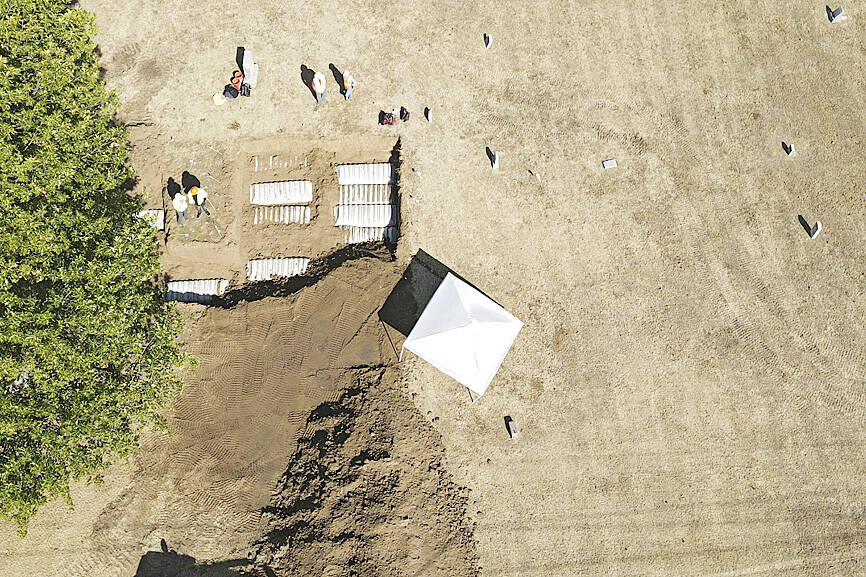A World War I veteran is the first person identified from graves filled with more than 100 victims of the 1921 Tulsa Race Massacre that devastated the city’s black community, the mayor said on Friday.
Using DNA from descendants of his brothers, the remains of C.L. Daniel from Georgia were identified by Intermountain Forensics, said Tulsa Mayor G.T. Bynum and officials from the lab.
The man was in his 20s when he was killed.

Photo: AP
“This is one family who gets to give a member of their family that they lost a proper burial, after not knowing where they were for over a century,” Bynum said.
A white mob massacred as many as many as 300 black people over the span of two days in 1921, a long-suppressed episode of racial violence that destroyed a thriving community known as Black Wall Street and ended with thousands of black residents forced into internment camps overseen by the US National Guard.
Brenda Nails-Alford, a descendant of massacre survivors and a member of the committee overseeing the search for victims, said the identification brought her to tears.
“This is an awesome day, a day that has taken forever to come to fruition,” Nails-Alford said.
More than 120 graves were found during searches that began in 2020, with forensic analysis and DNA collected from about 30 sets of remains. Daniel’s remains are the first from those graves to be linked directly to the massacre.
The breakthrough for identifying Daniel came when investigators found a 1936 letter from his mother’s attorney seeking veteran’s benefits.
Alison Wilde, a forensic scientist with Salt Lake City-based Intermountain Forensics, said the letter provided by the US National Archives convinced investigators that Daniel was killed in the massacre.
No members of Daniel’s family, many of whom do not know each other, attended the news conference announcing the identification, which was made earlier this week, Wilde said.
“I think it’s shocking news, to say the least” for the family, Wilde said. “We know we’ve brought a lot into their lives”
The massacre began when a white mob, including some deputized by authorities, looted and burned Tulsa’s Greenwood District. More than 1,200 homes, businesses, schools and churches were destroyed from May 31 to June 1.
Forensic anthropologist Phoebe Stubblefield said Daniel’s remains were fragmented and a cause of death could not be determined.
“We didn’t see any sign of gunshot wounds, but if the bullet doesn’t hit bone or isn’t retained within the body, how would we detect it?” she said.
Oklahoma state archeologist Kary Stackelbeck said the remains that were exhumed, including Daniel’s, were found in simple wooden boxes — and Daniel’s was too small for him.
“They had to bend his legs somewhat at the knee in order to get him to fit,” Stackelbeck said. “His head and his feet both touched either end of the casket.”
Investigators were searching for simple caskets because they were described in newspaper articles at the time, death certificates and funeral home records as the type used for burials of massacre victims, Stackelbeck said.
The next search for victims would begin on July 22, Bynum said.
“We’ll continue the search until we find everybody that we can,” Bynum said.
A lawsuit by the two known living survivors of the massacre was last month dismissed by the Oklahoma Supreme Court.
Attorneys for Viola Fletcher, 110, and Lessie Benningfield Randle, 109, are asking the court to reconsider the decision. Attorneys are also asking the US Department of Justice to open an investigation into the massacre under the Emmett Till Unsolved Civil Rights Crime Act of 2007, which allows for the reopening of cold cases of violent crimes against black people committed before 1970.

A fire caused by a burst gas pipe yesterday spread to several homes and sent a fireball soaring into the sky outside Malaysia’s largest city, injuring more than 100 people. The towering inferno near a gas station in Putra Heights outside Kuala Lumpur was visible for kilometers and lasted for several hours. It happened during a public holiday as Muslims, who are the majority in Malaysia, celebrate the second day of Eid al-Fitr. National oil company Petronas said the fire started at one of its gas pipelines at 8:10am and the affected pipeline was later isolated. Disaster management officials said shutting the

US Vice President J.D. Vance on Friday accused Denmark of not having done enough to protect Greenland, when he visited the strategically placed and resource-rich Danish territory coveted by US President Donald Trump. Vance made his comment during a trip to the Pituffik Space Base in northwestern Greenland, a visit viewed by Copenhagen and Nuuk as a provocation. “Our message to Denmark is very simple: You have not done a good job by the people of Greenland,” Vance told a news conference. “You have under-invested in the people of Greenland, and you have under-invested in the security architecture of this

Japan unveiled a plan on Thursday to evacuate around 120,000 residents and tourists from its southern islets near Taiwan within six days in the event of an “emergency”. The plan was put together as “the security situation surrounding our nation grows severe” and with an “emergency” in mind, the government’s crisis management office said. Exactly what that emergency might be was left unspecified in the plan but it envisages the evacuation of around 120,000 people in five Japanese islets close to Taiwan. China claims Taiwan as part of its territory and has stepped up military pressure in recent years, including

UNREST: The authorities in Turkey arrested 13 Turkish journalists in five days, deported a BBC correspondent and on Thursday arrested a reporter from Sweden Waving flags and chanting slogans, many hundreds of thousands of anti-government demonstrators on Saturday rallied in Istanbul, Turkey, in defence of democracy after the arrest of Istanbul Mayor Ekrem Imamoglu which sparked Turkey’s worst street unrest in more than a decade. Under a cloudless blue sky, vast crowds gathered in Maltepe on the Asian side of Turkey’s biggest city on the eve of the Eid al-Fitr celebration which started yesterday, marking the end of Ramadan. Ozgur Ozel, chairman of the main opposition Republican People’s Party (CHP), which organized the rally, said there were 2.2 million people in the crowd, but